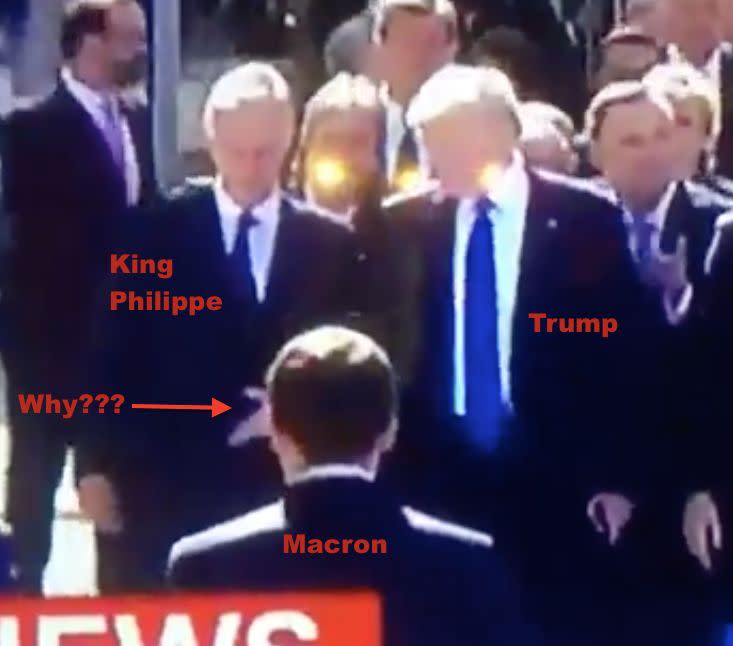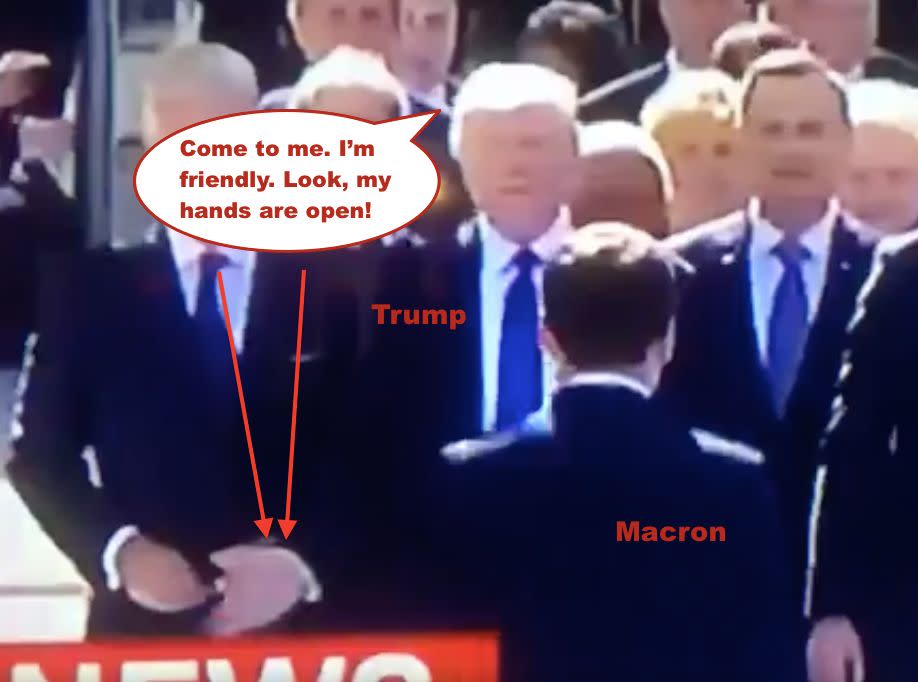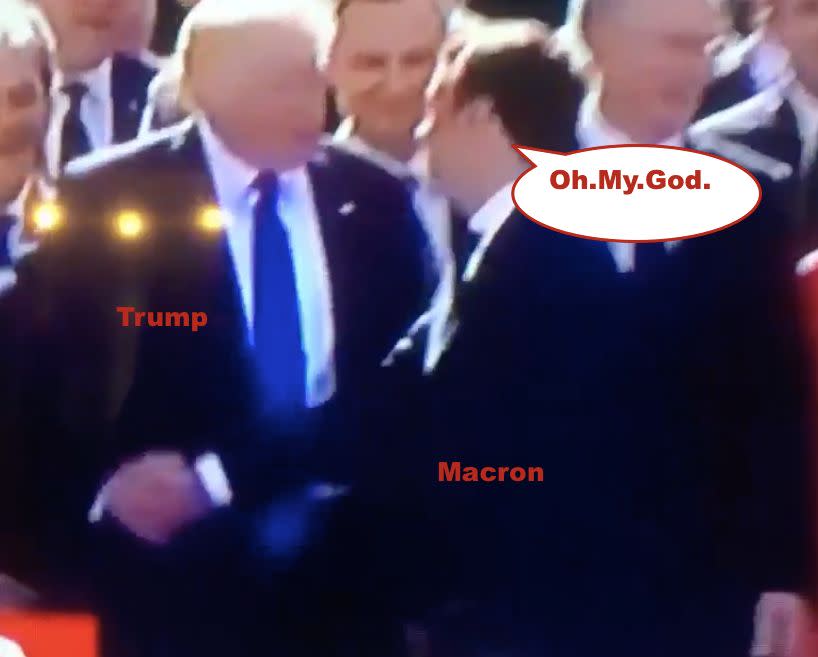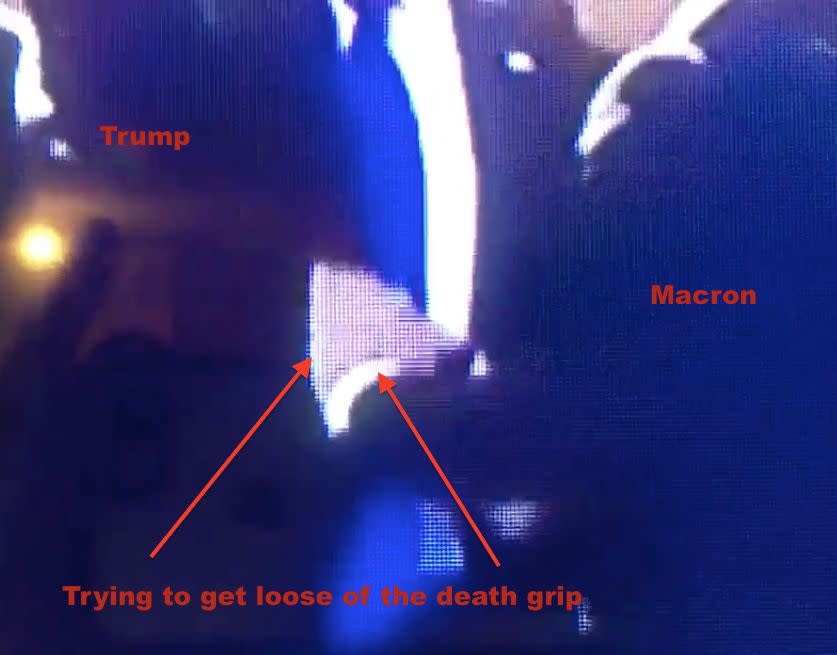The Madness And Science Behind The Donald Trump Handshake

Had French President Emmanuel Macron been paying close attention, he would have recognized quickly just how fraught his coming exchange with Donald Trump was to be.
The two leaders had met briefly earlier that day, exchanging a firm, prolonged, “not innocent” handshake that drew attention for its unbound intensity. Now, hours later, as Macron approached Trump and other world leaders at the opening of NATO’s new headquarters in Brussels last week, the U.S. president offered several non-verbal cues indicating his desire to re-establish the global pecking order.
The first came well before he and Macron were face-to-face. Walking toward each other, Trump reached out to King Philippe of Belgium, who stood directly to his right, to offer an impromptu handshake. The King seemed caught off-guard. For good reason. No one in their group was making any such gesture.
Trump’s offer seemed out of place. But Florin Dolcos, a University of Illinois associate psychology professor and faculty member at the Beckman Institute’s Cognitive Neuroscience Group, suggested it was a deliberate. And the intended audience wasn’t Philippe but Macron.
“That’s a signal Trump was sending: ‘This is where you should come first because I’m the alpha here,’” Dolcos said. “‘I initiated with the other guy.’”

Moments later, another cue. With the two still walking towards each other, Trump looked up at Macron and opened his arms ― a signal typically reserved for family and friends, not two world leaders who’d just met. Once again, Dolcos suspected Trump was making a nonverbal signal to his French counterpart.
“I think it is a learned behavior. Because typically you don’t do that. You do it with people very close to you in natural circumstances. Not people you don’t really know,” he said. “In a way it could be seen as a trap.”

Macron didn’t fall for it. Instead, he greeted a few others before making his way to Trump. When he did finally arrive, Trump pounced, taking Macron’s hand and pulling it violently away from his body with enough force to turn Macron roughly 50 degrees.

Dolcos again saw a tactical play. Unable to torque his arm, Macron was rendered powerless. He attempted to pull away and Trump refused to let him go.
Love HuffPost? Become a founding member of HuffPost Plus today.

Macron put his other hand on Trump to pry himself loose. And when he finally freed himself, Trump gave him a pat on the shoulder, ending the exchange squarely on his terms.

Another bizarre, dramatic, uncomfortable handshake with a world leader was in the books, bouncing its way across the Internet to the wonderment of all.
“It goes down to asserting dominance,” said Dolcos. “Why he wants to do that? I don’t know. It looks, to me, like he is trying too hard…. It looks ridiculous”
Macron blows off Trump, Trump responds by trying to rip his arm off? This is insane. pic.twitter.com/cPlPg7N72X
— Calvin (@calvinstowell) May 25, 2017
If you want to better understand Donald Trump ― his presidency, his approach personal diplomacy, even his psyche ― simply follow his hands.
Those hands, and their unexceptional digits, have been the source of immense insecurity, prompting him to lash out at critics and boast about his genitalia. They give insights into his marriage for the way they search ― ever so subtly and often unsuccessfully ― for his wife’s embrace. They tell us about his comfort in office as he attempts to find his footing on the world stage. And they illustrate his preoccupation with imagery and the role it plays in advancing his agenda.
“I just think the president is very cognizant of the optics of what it looks like at these multilateral meetings with world leaders,” said Sam Nunberg, a former Trump aide, “and I even think [the handshake] is symbolic to the America First theme of his presidency and campaign.”
The Trump handshake has become most unique greeting in all of politics. Before he nearly tore off Emmanuel Macron’s arm, Trump crushed the fingers of Japanese Prime Minister Shinzo Abe.
When he unveiled his Supreme Court nominee Neil Gorsuch during a East Wing ceremony, he followed suit by yanking the Justice’s entire body three times in his direction.
Trump memorably refused to shake hands with German Chancellor Angela Merkel when she visited him in a testy Oval Office exchange.
And he went grip-to-grip for an uncomfortable length of time with an obviously prepared Prime Minister Justin Trudeau of Canada.
In a short time, the Trump handshake has become so legendary that world leaders have been compelled to prepare in advance. Trudeau seemed to have done his homework and so had Macron during his first interaction with Trump. Hillary Clinton prepared for a variety of over-the-top Trump gestures in the lead-up to their debates. But her aide, Philippe Reines, who played Trump in debate prep, said the handshake never came up in practice sessions.
“I never tried to rip her arm out of its socket,” he told HuffPost.
Trump’s approach to the handshake is a combination of brute force and strategic discomfort. He doesn’t so much shake the hand as he consumes the very arm of the person he’s embracing. The goal, it appears, is to establish a geographic zone and bring his counterpart into it.
Trump almost always initiates, with a semi-open palm thrust at his counterpart. Often, his eyes dart not to the person across from him but down at his hand itself ― an early hint at where the drama will be. When the gesture is joined, Trump clasps firmly and tugs violently inward. Sometimes, he motions up and down but frequently he will use a lumberjack approach (back and forth). Occasionally, he’ll twist his counterpart’s hand in odd directions or use his free hand to fortify the clasp. Rarely does he let go first.
Unexpected recipients often seem stunned. Some, like Abe, show visible relief when it ends. And those who prepare in advance recognize it for what it is: an overt power play.
“It’s an intimidation tactic. There are self-preservation strategies and intimidation is one of the main ones,” said Frank Bernieri, an associate professor in the psychology department at Oregon State University, who has written on the influence of the handshake. “This is perfectly consistent with Trump. He pretty much says that’s what I do to make a deal.”
Handshakes were not invented as vehicles to exhibit dominance. In their earliest depictions, they were seen as means of sealing alliances and exhibiting intimacy. Research says that handshakes can leave lasting impressions about a person’s conscientiousness and that different variables can affect the efficacy of the handshake. What is less agreed upon is the ability of handshakes to assert authority.
The handshake as a power move has been mythologized in film and popularized in the world of business. But some researchers say that as a practical matter, it doesn’t actually work.
“Such attempts would usually be ineffective because the main point of a handshake is to establish a sense of mutuality and mutual respect,” emailed Howard Friedman, editor-in-chief of the Journal of Nonverbal Behavior and a professor in the psychology department at the University of California, Riverside.
“[S]omeone who uses or attempts to use such a power or intimidation handshake either 1) already has the power and would also simultaneously be employing other status signals like elevated height, invasive touching, higher-status clothing, and other dominance cues from face, voice, gaze, and posture; or 2) is misjudging the likely reactions of the other person and/or the audience,” Friedman said.
Trump doesn’t abide by this theory. His handshakes are clear attempts to assert alpha dominance.
Take when Trump greeted Tajikistan president Emomali Rahmon. In this incident, Rahmon played the role of the aggressor, grabbing and shaking Trump’s hand in the same manner as Trump did with Macron. What impressed Dolcos is what came next. Instead of pulling away ― which is the natural inclination ― Trump stepped closer in. Doing so allowed his arm to once again be torqued, which, in turn, allowed him to re-establish physical control and affirm his stature within Rahmon’s own orbit. It was a “rebalance of the power play,” as Dolcos put it. “It is a little bit of body rotation so it looks natural.”
Those close to Trump say they don’t believe he rehearses these moments. But Dolcos suspects that he does. The patterns are so apparent and the gestures so demonstrable that it seems only natural that Trump has thought them through. That’s true even in instances where there is no handshake at all.
At an earlier stop in his trip abroad, Trump met with Israeli Prime Minister Benjamin Netanyahu. After the two sat for the camera, Netanyahu stood up first and offered his hand. Trump ignored the gesture, walking the other way.
LOL. Trump got the handshake second time.
pic.twitter.com/oZmeWUbmFQ— Billy Bongo (@BishBashBongo) May 22, 2017
Observers assumed that Trump either didn’t notice his counterpart or got lost in the moment. Dolcos had a different theory.
“It is another way of establishing rank, which is that he is the one initiating,” he said. “‘I’m not going in when you initiate. I’m probably ignoring it and then I’ll come back. This is now when we are doing this. Not when you initiate it.’”

The most curious part of Trump’s handshake is that he reportedly hates shaking hands. He has called such greetings “barbaric” and “one of the curses of American society.” He is a rumored germaphobe who dispenses Purell sanitizer.
And yet, despite those hesitations, Trump entered a field where the handshake is even more fundamental than in the world of business. Politics is built on handshakes.
Neil Makhija was a body man for Joe Sestak when the Democrat ran unsuccessfully in 2010 for the Senate in Pennsylvania. He recalled how his boss would weave back-and-forth, side to side during July 4th parades instead of walking down the middle of the street. He wanted to shake every hand he could touch.
“There is a tendency among politicians that if you reach a voter they will kind of see the light,” Makhija said. “You think the more people you touch, the more likely you will win.”
Makhija went on to become an advance man for Vice President Joe Biden and, once again, handshaking found its way into his portfolio. Whenever Biden would meet a politician or dignitary, his aides would game plan the meeting, including that initial greeting.
“There is no question that when you have an advance team for the White House, every single detail is discussed in terms of where the shake is going to happen, what is the backdrop and what’s behind you and all these things,” said Makhija.
Unlike Biden or Sestak, Trump doesn’t see the handshake as a means of establishing cordiality or mutuality with his counterpart. He doesn’t conceive of it as means of winning votes or facilitating diplomacy. He imagines it as a display of alpha-ness. This makes him unique among U.S. presidents and a marvel for the YouTube age. Then again, what else would one expect from Donald Trump?
“If we are talking about his handshake, it is kind of analogous to us talking about him when he takes his finger and says, ‘You’re fired,’” said Nunberg. “There is nobody who is a better showman and more cognizant of the optics than I’ve ever worked with than him.”
This article originally appeared on HuffPost.

